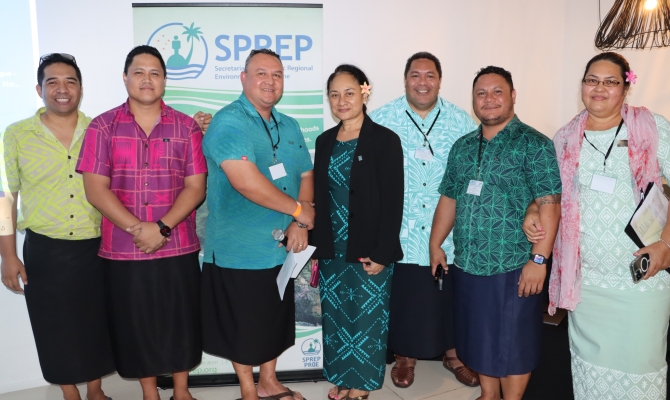
06 September 2023, Apia – The application and leveraging of digital technologies to address environmental issues was highlighted during a side event at the 31st SPREP Meeting of Officials in Apia, Samoa, on Wednesday.
The Vanuatu Klaemet Infomesen blong Redy, Adapt mo Protekt (Van-KIRAP) project and the Pacific Regional Invasive Species Management Support Service (PRISMSS) shared their work in utilising the technology to advance the conservation and protection of the Pacific environment with delegates during the event.
According to SPREP Director General, Mr Sefanaia Nawadra, one of the key lessons the Secretariat learned during the COVID-19 pandemic was the need to strengthen its virtual platforms and virtual capacity to make information and technical support more accessible and easily available for Members in the absence of international travels and in-country support.
“This is in addition to the need to ensure that the information available to Members is secure, and the details of those providing the information are also secure. Our Information and Communication Technology Policy is our guiding document to ensure as much as possible that this happens,” Mr Nawadra added.
Mr Sunny Seuseu, Acting Project Manager for Van-KIRAP, highlighted the Vanuatu Climate Watch App which was launched earlier this year in collaboration with the Vanuatu Meteorological and Geohazards Department (VMGD) within the Ministry of Climate Change, the Climate and Oceans Support Programme in the Pacific, the Australian Bureau of Meteorology, and EarthWatch.
“The purpose of the Climate Watch App is to aid the monitoring of traditional knowledge indicators in Vanuatu,” Mr Seuseu said. “There are several traditional climate indicators in Vanuatu such as turtles, plants, and animals. These are indicators that have been used by ni-Vanuatu for centuries to predict the weather patterns and behaviours. At present, the current traditional knowledge monitoring system is done by using paper-based forms and can only be carried out by a small number of individuals.”
This presents challenges such as postage costs, return time delays, and the limited number of people who can carry out the monitoring do not cover all 80 islands spanning a total of 1,300 kilometres.
The Climate Watch App is a solution developed to address these challenges. Available for free on both the App Store and Google Play, the app allows users to make observations on various traditional climate indicators, and that information will be made available instantly to the VMGD team.
“The App is a Citizen Science project, which means that anyone and everyone can be a part of it. We have launched this app to schools in Vanuatu first and have included Species Guides within the app as a learning aid, providing photos of what each indicator species looks like, where and when they can be found, what to observe, and other useful information that will help users of the app to better understand the indicators.”
Mr Joseph Pisi, Regional Coordinator for the GEF6 Regional Invasives Project, highlighted a tool which can be used by countries to request for assistance with invasive species issues from the Secretariat, specifically from the Pacific Regional Invasive Species Management Support Service (PRISMSS).
PRISMSS is a coordinating mechanism designed to facilitate the scaling up of operational management of invasive species in the Pacific. It brings together experts to provide support within the Pacific region with a focus on protection of indigenous biodiversity and ecosystem function, with the intention of providing a comprehensive suite of support services in a cohesive, effective, efficient and accessible manner to Pacific Island countries and territories.
The tool, known as the Nagivator, integrates all Invasive Species systems in one.
“One very important function of the Navigator that is available for use by the public is a request form which they can use to request assistance from the Invasives team for technical advice, capacity building, operations support, and project development,” Mr Pisi said.
“When a request comes in, it is assigned to a relevant PRISMSS programme depending on the nature of the request, and assigned to the relevant PRISMSS partner who will communicate the requested assistance to the country.”
So far, a total of 122 requests have been received through the Navigator platform, with nine requests completed, valued at more than $800,000 USD.
The 31st SPREP Meeting of Officials and associated meetings are taking place at Taumeasina Island Resort in Samoa this week, from 4-8 September 2023. The meetings are guided by the theme: “SPREP@30th Sustainable, transformative and resilient for a Blue Pacific.”
The 31st SPREP Meeting of Officials and associated meetings bring together SPREP's 21 Pacific Island Member countries, 5 Metropolitan Members and partners to discuss strategic issues pertaining to the organisation, and to approve the 2024-2025 work plan. The 21 Pacific Island Member countries and territories of SPREP are: American Samoa, Commonwealth of the Northern Marianas, Cook Islands, Federated States of Micronesia, Fiji, French Polynesia, Guam, Kiribati, Marshall Islands, Nauru, New Caledonia, Niue, Palau, Papua New Guinea, Samoa, Solomon Islands, Tokelau, Tonga, Vanuatu and Wallis and Futuna. The five Metropolitan members of SPREP are: Australia, France, New Zealand, United Kingdom and the United States of America.
In our efforts to fulfil our vision of ‘a resilient Pacific environment, sustaining our livelihoods and natural heritage in harmony with our cultures’, SPREP is extremely grateful to our valued Members, development partners, donors, our CROP family, and stakeholders.
For more information on the 31SM, please contact: sprep@sprep.org